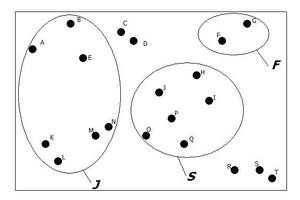The Addition Rule
Consider the population consisting of the students at a high school who are members of the student council.
A diagram can be used to visualize this population. To construct such a diagram, a rectangle is drawn to represent the population, and each student on the student council is represented by a labeled point in the rectangle.
Here is the diagram for this population:

-
How many students are on this student council?
-
The given diagram also represents the sample space for the chance experiment of selecting a student at random from this population. For this chance experiment, what is the probability that student K is selected? Justify your answer.
-
In a diagram, an event can be represented by a shape (often a circle or oval) that encloses the outcomes that make up the event. Consider the following events:
F= the event that the selected student is a freshman
S = the event that the selected student is a sophomore
J = the event that the selected student is a junior
Which of the following diagrams could be a representation of these three events? Explain your choice.
Diagram 1

Diagram 2

Use Diagram 2 above to answer questions d – f.
-
If a student is selected at random from the council, what is P(J), the probability that the selected student is a junior? Justify your answer.
-
Is P(F) = P(J)? Explain why or why not.
-
Use Diagram 2 to find the following probabilities:
a.P(F)
b.P(S)
c.P(F or S)
Now consider Diagram 3 shown below. This diagram contains the two events
J = event that the selected student is a junior
M = event that the selected student is male
Diagram 3

-
Shade the region where the two ovals overlap. What event is represented by this shaded region?
-
Use Diagram 3 to find the following probabilities:
a.P(J)
b.P(M)
c.P(J or M)
d.P(J and M)
-
Explain why P(F or S) = P(F) + P(S)(see question 6) but P(J or M) ≠ P(J) + P(M).
-
Can you come up with a way to calculate P(J or M) using the other three probabilities calculated in question h? Write this as a formula in the form
P(J or M) =
-
Explain why your formula in question j makes sense in terms of Diagram 3.
-
In general, suppose A and B are two events. Write a formula for calculating P(A or B) in each of the following two cases:
Case 1:A and B are mutually exclusive (A and B have no outcomes in common)
Case 2:A and B are not mutually exclusive
-
The formula for Case 2 in question l is called the General Addition Rule. This rule also works for calculating P(A or B) when A and B are mutually exclusive. Explain why this is the case.
-
Write a sentence or two explaining how to calculate the probability of the union of two events.
